When you are an experienced vegetable gardener, it makes sense to save the seeds from your own crops for future plantings and food.
Seed saving can save you money, and it is a fun way to geek out, gardener style.
Each plant can make more than 1,000 flowers, so for every carrot you let go to seed now, you might be able to grow a thousand in the future.
We link to vendors to help you find relevant products. If you buy from one of our links, we may earn a commission.
It’s pretty simple to figure out that saving seeds is worth the extra work this gardening project requires when you look at it that way.
You need to take a few important steps with your current crop right now if you want to get the best harvest from your future garden.
Since these root vegetables are biennials, saving their seeds is a two-year process. And you’ll need to start in the first year if you want to grow carrots that are true to type.
Most people who garden in their own yards should only plant one type of seed to get a crop that grows exactly like the seed. We’ll explain why in the next section.
But don’t pick just any cultivar. Make sure you choose one that is open-pollinated rather than a hybrid.
When plant breeders make a hybrid vegetable, they pick each parent plant for its own unique qualities. For example, one parent plant might have long orange roots, while the other might have a very sweet flavor.
The first generation of plants from the F1 hybrid will have these chosen traits. However, if you let those carrots grow to maturity, you can’t be sure that the seeds they produce will be true to type or keep the traits of the parent plant.
Seeds from hybrids may produce plants with desirable traits – or they may have undesirable ones. With hybrids, the seed may also fail to be viable at all.
Pick an open-pollinated type to begin with to be sure you know what to expect when you plant your saved seeds.
Our list of the 13 best varieties of these root vegetables has some open-pollinated cultivars that you can look at if you need some ideas.
Of course, saving seeds is a way to grow food, but it’s also a way to keep the genes from the varieties you like so that you can get more consistent results.
With the goal of getting plants with the traits you want, you will need to keep your chosen plants separate from other types.
These plants get pollinated by either pollen from other cultivars that is floating in the air or, more likely, by bugs that visit flower after flower to feed on the nectar and spread pollen.
If there are other kinds of carrots growing nearby, the pollen from those carrots could fertilize your flowers, which could lead to seeds with strange or unwanted traits when they are planted.
For home gardeners, distance is the best way to keep your carrots separate and the next generation predictable.
Professional growers sometimes use seed isolation cages, but then they either have to hand-pollinate flowers or introduce pollinating insects in a controlled way, which isn’t an easy process.
Instead of using isolation cages, many commercial growers use “isolation by distance,” which means they set aside large areas of land to grow only certain cultivars.
How far away from other types of plants does your crop need to be in order to be isolated by distance?
J. E. Ells and D. Whiting at the Colorado State University Extension recommend isolating carrots at a radius of 1/4 of a mile.
But the distance needed to successfully separate the carrots will depend on things like buildings and plants in the way, as well as the weather where you live—how humid and windy it is.
In humid places like Virginia, a mile is a good distance. But in drier places like the southwest, where hot, dry winds can damage pollen in the air and make it hard for bugs to move around, 1/4 of a mile might be too far.
Since these things can change, I suggest you start with a 1/4-mile radius and plant a small batch where you are to see if your saved seeds are growing true.
These people might be happy to grow the same variety of plant with you for a year if you offer to share your seeds.
Don’t let Queen Anne’s lace or “wild carrot” (Daucus carota) get near your plants either. It’s the same species as the domestic carrot and can easily pollinate your plants.
As with other carrot varieties, Queen Anne’s lace can introduce some undesirable genes into your seed crop, which can lead to unpredictable colors and flavors in your future harvests.
Queen Anne’s Lace is considered an invasive weed and can grow in disturbed areas, pasture, and hay fields.
When on the lookout for this weed, it can be hard to differentiate from carrot foliage.
But the difference is clear below ground: Queen Anne’s lace has a long, thin taproot and secondary roots that are fibrous and woody.
If you have Queen Anne’s lace on your property, according to J. The best way to control it, according to Colquhoun and his co-authors at Oregon State University, is to plow it under the ground and plant a different crop in its place, or to mow it down.
It might sound like a lot of work to separate your carrots from other cultivars and Queen Anne’s lace, a wild relative of carrots. But the good news is that you only have to do this when your crop is flowering, which is in its second year of growth.
So you can grow a lot of different kinds the first year, pick the ones you want to eat, and leave some of your favorite variety in the ground to grow seeds the next year.
Additionally, you should remember to save at least five plants so that you can use them to make seeds, which I will explain in more detail below.
For the first year, whether you grow more than one type, you should make sure to mark your crop in some way.
This will serve as a visual reminder that some of these plants should stay in the ground and not be picked for food this year.
I recommend doing this in year one, at the time when you first plant your root veggies.
Also, if you want to learn more about how to grow carrots in your garden the right way, check out our guide.
Putting up physical plant markers or drawing a detailed map of your garden in your garden journal are both great ways to keep track of your plants.
I like these zinc plant markers that can be used more than once. They will not only help you keep track of your crops, but they will also look great in your garden.
Like kale, carrots are biennial plants, which means they require two growing seasons to complete their reproductive cycle.
What tells the plant between these two growing seasons that it’s time to start making more plants?
Vernalization triggers flowering in biennial plants. Your biennial crop needs to experience cold temperatures in order to mature and begin its reproductive cycle.
If the temperature in your area stays below 59°F for at least 10 to 12 weeks, you can let your crop overwinter in your garden.
Your carrots can stay in the garden even if the ground freezes solid in the winter if they are well mulched. This is what I do.
This root crop can survive the winter in Zone 5a, where the lows can drop to -20°F.
If you don’t want your garden to stay in the ground over the winter because it’s too hot or too cold, you can dig up your roots before the first hard frost and let them get warm in a fridge, root cellar, or cool basement.
If you are saving carrot seeds instead of eating them, you can harvest and store them the same way you would any other crop that you want to keep for a long time:
Look for healthy plants when choosing ones to save seeds from. Get rid of any that bolted during their first growing season or have leaves that look like they aren’t doing well.
If you want to grow carrot seeds from store-bought carrots, keep in mind that you probably won’t know what kind of carrots you are planting.
Also, most carrots sold in stores are hybrids, so the next generation probably won’t be the same as the root you started with.
Carrot roots that have been stored to make seeds should be planted again in the garden in the spring, at the same time that carrot seeds are planted.
Just make sure to replant only healthy looking roots. Some carrot roots might not make it through the winter, so if any of them start to rot, put them in your compost.
Roots that were stored over the winter should be planted at the same depth they would have grown at before, with the tops of the roots sticking out a little from the ground.
Make sure there is 3 feet of space between each plant, whether it was overwintered or stored for the winter. These vegetables will need more room in their second year of growth.
Remove carrots carefully so you don’t hurt the plants you want to leave in the ground if you need to thin your bed to give plants more room to grow.
Unearthing the Origins of Carrot Seeds
Carrots are a popular root vegetable grown in gardens worldwide. But have you ever wondered where the seeds come from to grow these tasty, nutritious roots? Carrot seeds actually originate from the flowers of the carrot plant, which emerge in the plant’s second year of growth. Here’s an in-depth look at the life cycle of the carrot and how to collect and save seeds from your own carrots.
The Carrot Growth Cycle
Carrots are biennial plants, meaning they take two years to fully complete their lifecycle. In the first year, carrots grow only foliage and their edible taproots. It’s not until the second year that the carrot plant flowers and sets seeds. Once this happens, the carrots become woody and inedible.
In areas with mild winters, carrots may bloom in late winter of the first year But generally flowering occurs in early summer of the carrot’s second year The flowers appear in tall stalks that can reach 3-4 feet tall. The blooms cluster into umbels, similar to other plants in the Apiaceae family like dill and parsley.
The flowers first appear white, then gradually change to a pink or light purple hue. Once pollinated by bees and other insects, the flowers fade and are replaced by seeds. The seeds are contained in small, dry fruits called schizocarps. One umbel may contain several hundred seeds.
Collecting and Saving Carrot Seeds
To collect seeds from your own carrots, here are some tips:
-
Leave some carrots in the ground over winter to allow them to flower in spring. Mark the spot where they’re planted.
-
Once the flower umbels turn brown and dry, cut them off the plant and place them in a paper bag.
-
Further dry the seed heads for 1-2 weeks. Break open the heads and separate out the individual seeds.
-
Discard any seeds that are damaged, misshapen or very small. Select large, plump seeds for saving.
-
Place the dry seeds in an airtight container and store in a cool, dry place until ready to plant. Carrot seeds remain viable for 2-3 years.
-
When planting saved carrot seeds, add a fresh batch each year to maintain viability. carrots cross-pollinate freely, so seed-saved varieties may not come true from parent plants.
Where to Buy Carrot Seeds
For gardeners who don’t want to save their own seeds, carrot seeds can be purchased from garden centers, nurseries, hardware stores, or online seed retailers. Popular varieties include:
-
Danvers – Bright orange roots with great flavor, around 6-7 inches long.
-
Nantes – Sweet roots that grow 5-7 inches long, great for eating fresh.
-
Chantenay – Deep orange, stump-rooted carrots perfect for heavier soils, 3-5 inches long.
-
Mini/baby – Small, round carrots perfect for containers or kids’ gardens.
-
Rainbow – Mix of purple, yellow, and orange carrots for a colorful harvest.
-
Heirloom – Open-pollinated, non-hybrid varieties passed down through generations.
When purchasing seeds, opt for disease-resistant, vigorous varieties suited to your growing zone and season length. Make sure to check the seed packet for planting times and care instructions specific to that carrot variety.
The Fruits of Your Labor
Now you know that those tiny carrot seeds actually come from the dried fruits of second-year carrot flowers. By collecting seeds from your own plants or purchasing them from retailers, you can continue the cycle of growing these nutritious and tasty root crops. With the right variety, care, and harvesting techniques, you’ll be rewarded with a bountiful crop of beautiful carrots.

Let Your Crop Grow
Finally, the easy part. Your carrots are now in their second year of growth, so it’s time to see the leaves grow and the flowers with seeds start to form.
As soon as it gets warm in the spring, new growth will appear on top of your carrots. In 4 to 6 weeks, the flower stalk will appear.
Keep your crop watered as you would normally, and keep your eye out for pests or disease. Remove any infected plants immediately.
It might surprise you that these flowers look a lot like those of dill, caraway, and other umbellifer plants if you’ve never let your carrots flower before.
Soon, the green umbels will start to bloom into an umbrella-shaped cluster of tiny flowers. During this time, they will attract a huge number of helpful pollinators.
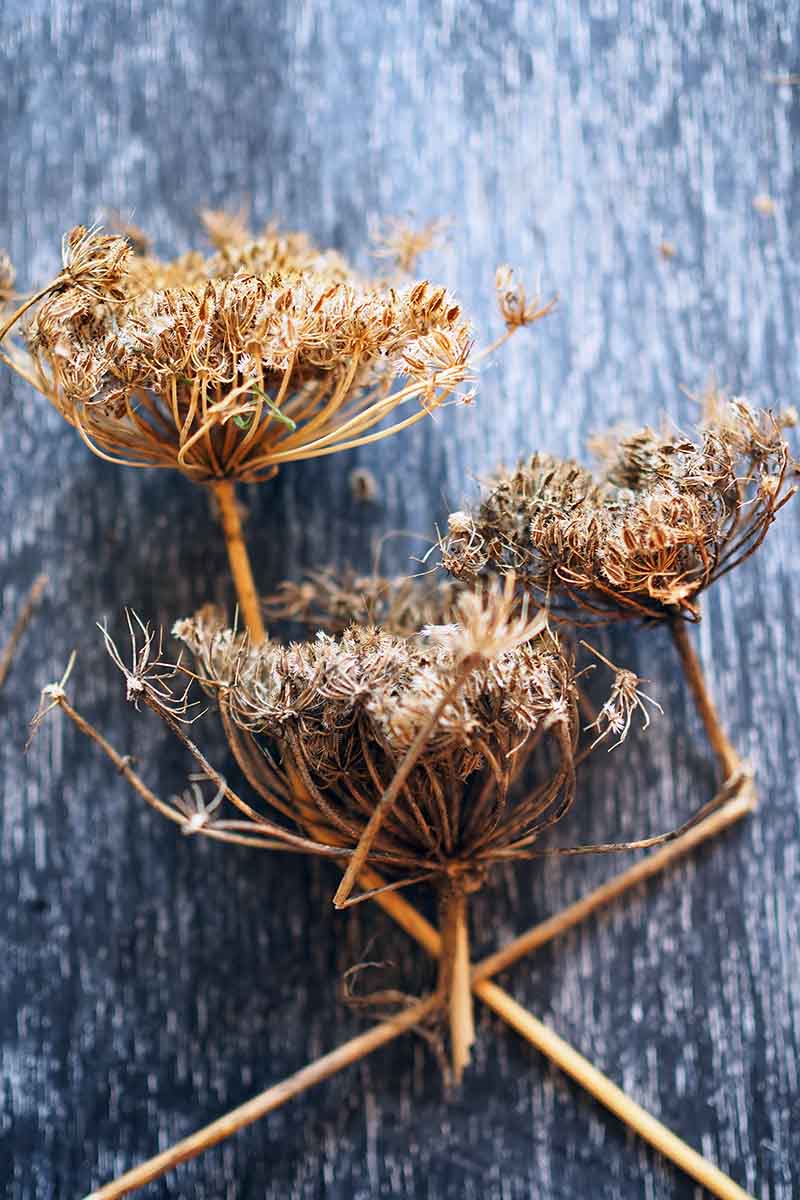
As the summer goes on, these pretty umbels will dry out and turn brown. This is when you should gather your seeds.
When you choose which umbels to harvest, collect them from several different plants.
Seed Savers Exchange recommends harvesting from at least 5 plants, but preferably 20 – to make sure you obtain enough seed that’s viable, and to ensure genetic diversity and resilience.
Also, choose the plants that look the healthiest to keep the strongest sets of genes. Don’t bother saving seeds from plants that are sick or full of bugs.
Clip off the dry umbels with pruners and place them in brown paper bags. Do not pack them in too tightly as they need good ventilation to prevent mold from growing.
Place the bags in a dry spot in your home to allow the umbels to finish drying out.
You can also lay the umbels out flat on a screen or other flat surface to dry in a single layer. This way, they will get enough air flow.
You will know they are thoroughly dry when the plant material is brittle instead of pliable.
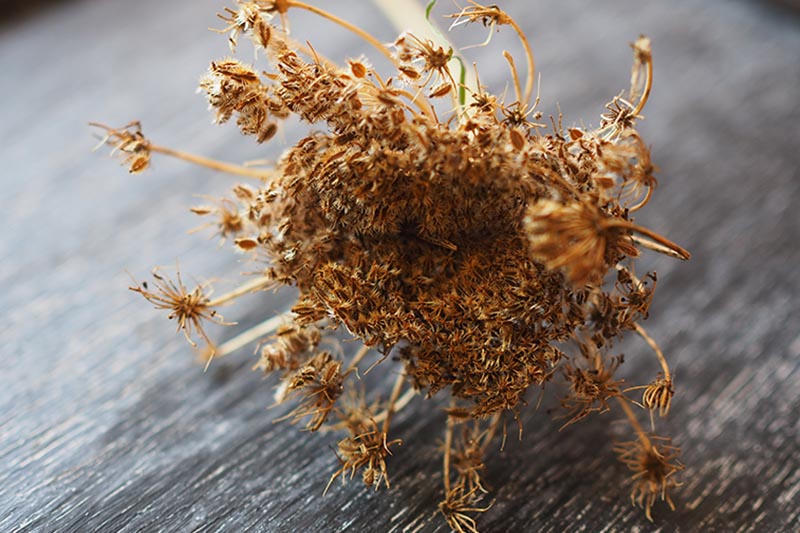
Once your flower umbels are dried out, it’s time to remove the seeds.
By separating the seeds from the umbel, you can store them in a smaller container and get rid of the chaff, which takes up space and could be a source of mold or disease.
When picking a small group of umbels, like the ones most people grow in their backyards, you don’t need any special tools.
I do this with just a few items from my kitchen.
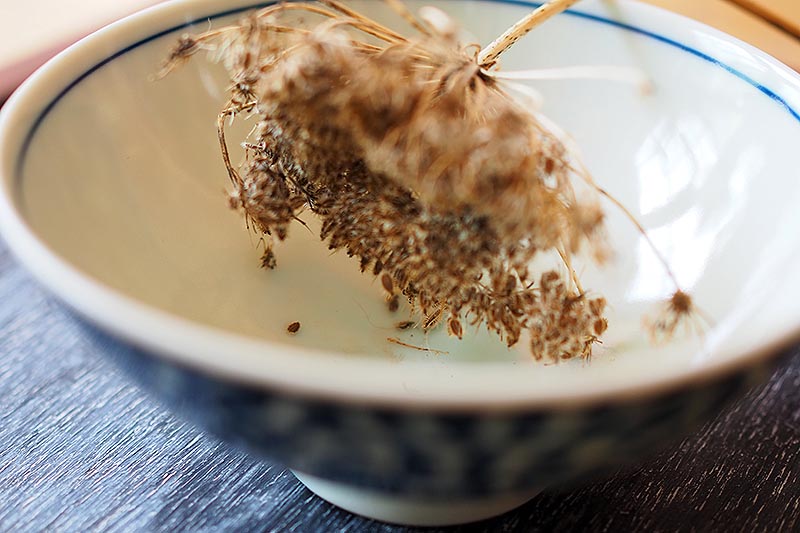
First, you want to remove the seeds from the umbel.
Grab a bowl or plate and put one of the umbels on top of it. Then, rub it between your fingers to come the seeds off the flower head.
Generally, good quality seed will not have any problems being handled this way. If it disintegrates when rubbed, it is likely not viable anyway.
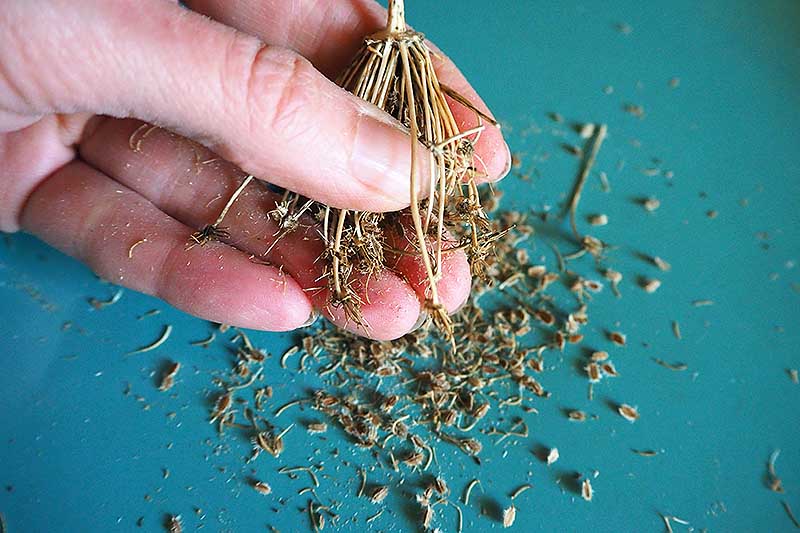
This way of rubbing the umbel will make a pile of spiky carrot seeds mixed with bigger pieces of debris, or chaff.
Pick out the larger pieces of chaff until you are left with just the spiky carrot seeds.
Typically seeds are separated from chaff by winnowing, as many plant seeds are heavier than chaff. This is not the case with carrot seeds, which are quite light.
Professional growers use screens to let the carrot seeds fall through and filter out the bigger pieces of dirt. Most home gardeners don’t need this tool, though.
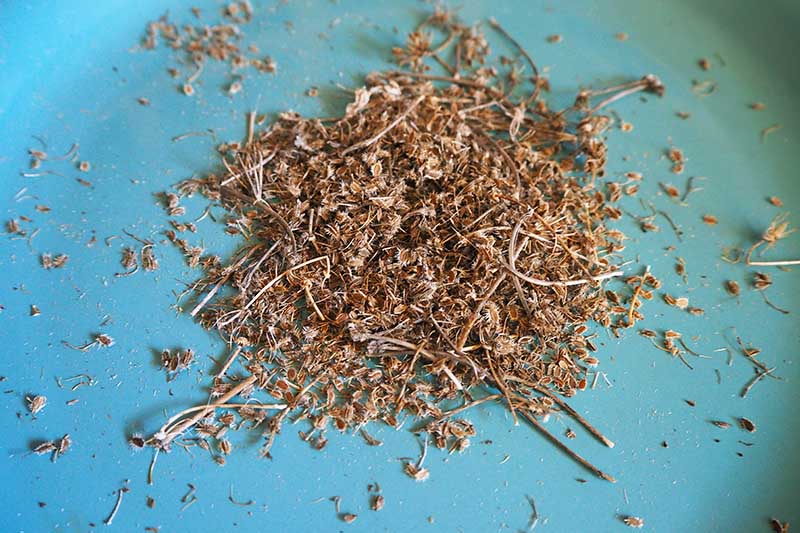
After removing large pieces of chaff, then use your fingers to rub the spikes off the seeds.
These spikes are the plant’s way of ensuring its seeds are dispersed.
The hook-like spikes on burs and these seeds’ spikes can easily get caught on animal fur and be moved to a new spot where a new plant can grow.
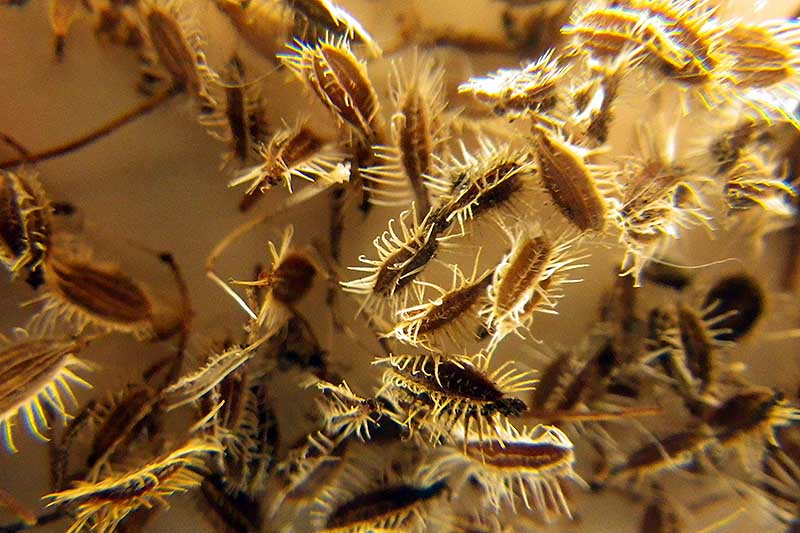
It’s not necessary to take these spikes off in order to grow new crops, but it will make storage smaller.
After cleaning the seeds, I like to put them in a sieve and rub them against the mesh to get rid of any last spikes and small pieces of dust-like debris that don’t want to get into my seed packets.
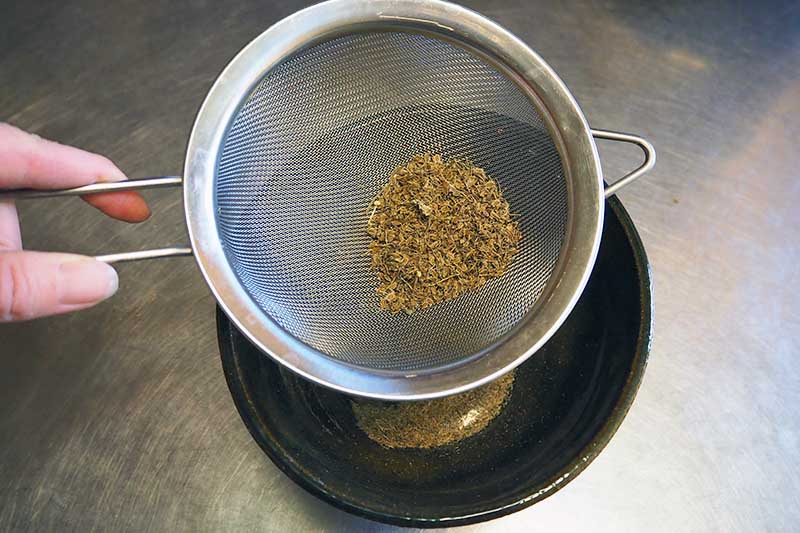
Keep taking out the bigger pieces of trash from the sieve and give it a light shake to get rid of the smaller dust particles.
At this point, the carrot seed should be pretty clean and ready to be stored for next year’s planting.
Next, you’ll want to store your clean and dry carrot seeds. They can be kept in any kind of container, but I like to keep mine in small paper envelopes.
Mice can’t get into airtight containers like jars, but they take up more space and are more likely to get moldy if the seed isn’t completely dry.
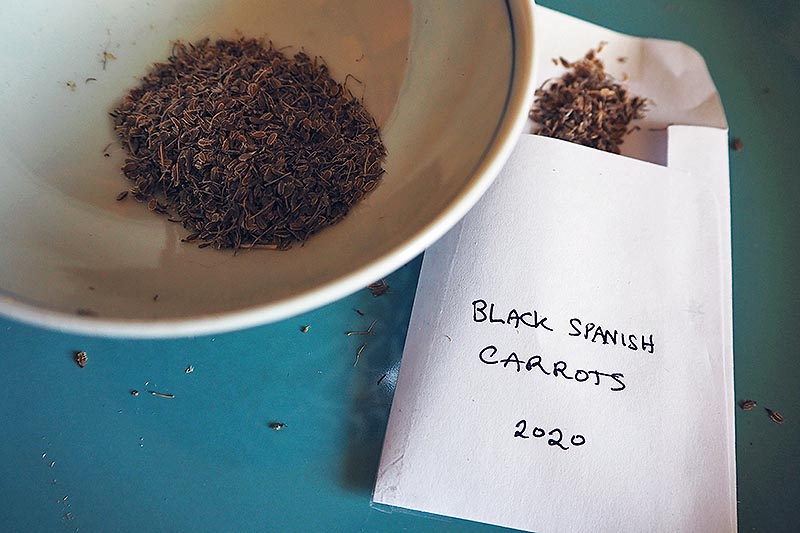
Regardless of the type of container you use, make sure to write down the plant type, cultivar name, and harvest year on it. This way, you won’t end up with packets of unknown seed in the future.
Most of the time, I use junk mail envelopes that I would have thrown away to make my own little storage bags.
But if you want to take your gardening hobby up a notch, you can store your seeds in more professional looking envelopes, such as these small blank kraft storage envelopes that are available from Amazon.
Once your carrot seeds are packed into their envelopes, store them in a cool, dark, dry place.
You can put silica packets next to your seed envelopes or inside the jars to help keep the humidity down if you live in a humid area.
You can count on these being viable for about three years, on average.
I suggest giving them to other gardener friends if you have too many to use yourself in that time frame.
Or use your extras for fun indoor experiments, such as growing these root veggies indoors.
Never Buy Seeds Again – How to Collect Carrot Seeds
FAQ
How do you get seeds from carrots?
Where is the carrot seed?
Can you get carrot seeds from carrot tops?
How do you scatter carrot seeds?
What variety of carrot seed is used in the US domestic market?
The Imperator 58 variety is one of the most popular types of carrot for growing at home. It produces large, bright-orange carrots. MySeeds.Co brings the most variety pack of carrot seeds.
Where is carrot seed grown in the US?
Approximately 55% of the US domestic market carrot variety seed production is grown in Jefferson County, and an additional 10% in Crook and Deschutes Counties. In addition 45% of the Global market carrot variety seed production is grown in Jefferson County.
What types of carrot seeds are available?
To get started, these are the best carrot seeds in several different varieties. The Imperator 58 variety is one of the most popular types of carrot for growing at home. It produces large, bright-orange carrots. MySeeds.Co brings the most variety pack of carrot seeds.
Are there any special features of carrot seeds?
Most of the carrot seed is “hybrid”, with male and female plants that cross pollinate, through honeybees that are brought in, to increase seed vigor. You may notice the male and female rows separated by blank rows.
- The Ultimate Guide to Growing Strawberries in Raised Beds - August 8, 2025
- No-Dig Garden Beds: The Easiest Way to Grow a Beautiful Garden - August 6, 2025
- How to Protect and Preserve Wood for Raised Garden Beds - August 6, 2025
